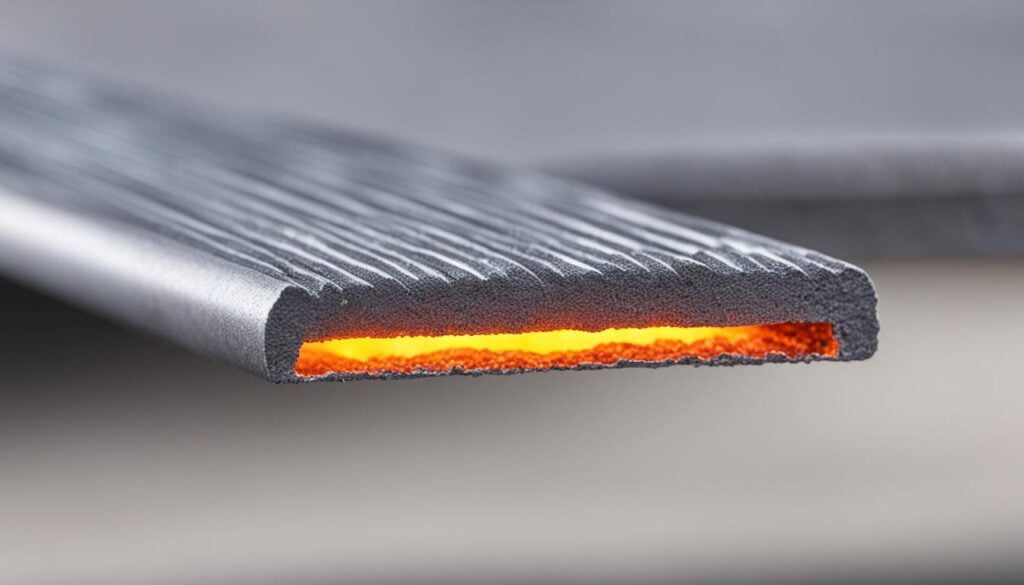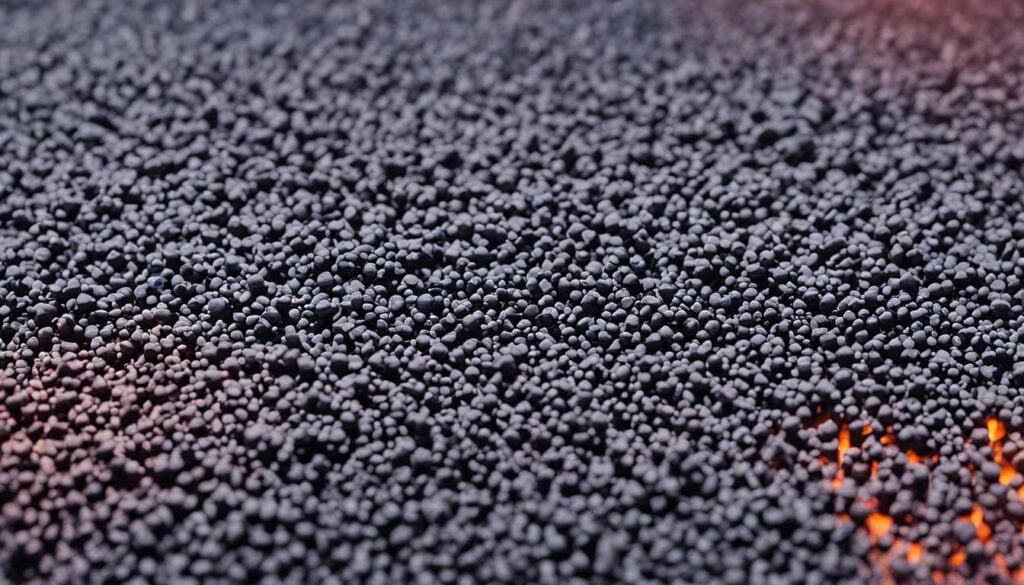Gray iron, known for its distinctive gray color due to graphite fractures, is a top choice for industrial applications because of its thermal conductivity. This metallurgical feature is crucial in components such as engine cylinder heads and brake systems, where efficient heat transfer is essential. KT-Foundry specializes in gray iron castings, providing products that offer excellent mechanical properties and superior ability to manage heat compared to other materials. The graphite flakes in gray iron are advantageous for temperature control, particularly in high-temperature environments, making it a preferred material for various uses, including machinery bases, gears, and hydraulic components. Gray iron’s high thermal conductivity stems from its unique graphite structure, enabling effective heat dissipation and contributing to the material’s overall performance and durability in industrial applications.
Key Takeaways
- Gray iron is a favored material in industrial applications due to its thermal conductivity.
- KT-Foundry specializes in gray iron castings with excellent mechanical properties and heat management capabilities.
- Graphite flakes in gray iron play a crucial role in temperature control, especially in high-temperature environments.
- Gray iron’s thermal conductivity contributes to its performance and durability in demanding industrial settings.
- Applications like engine cylinder heads and brake systems benefit from gray iron’s efficient heat dissipation.
The Significance of Thermal Conductivity in Gray Iron Applications
Thermal conductivity plays a crucial role in the automotive industry, particularly for critical components such as engine cylinder heads and brake systems. Gray iron’s high thermal conductivity ensures efficient heat transfer and dissipation, contributing to the material’s overall performance and durability in various industrial applications.

Why Thermal Conductivity Matters for Engine Cylinder Heads and Brake Systems
Engine cylinder heads and brake systems demand materials with excellent heat transfer efficiency to maintain optimal performance and prevent damage. Gray iron castings from KT-Foundry meet these requirements, providing superior thermal conductivity along with good mechanical and friction properties. Comparative studies have shown that gray iron consistently outperforms compacted graphite iron (CGI) in terms of thermal conductivity, particularly in high-temperature applications like brake discs, where efficient heat dissipation is critical to ensure improved service life and performance.
Advantages of Gray Iron in High-Temperature Environments
Gray iron’s high thermal conductivity enables rapid heat transfer, reducing the risk of thermo-mechanical fatigue, deformation, and hot cracking in industrial components subjected to high-temperature environments. This quality ensures enhanced durability and longevity of products, making gray iron an ideal choice for parts such as engine blocks, pumps, and valves. Furthermore, gray iron’s ability to withstand thermal cycling, where components frequently experience variations between warm and cold temperatures, allows it to be less susceptible to stress and failure under such conditions. KT-Foundry’s gray iron castings offer this crucial advantage, underlining the material’s suitability for demanding industrial uses.
Optimizing Thermal Performance in Industrial Applications with Gray Iron
Utilizing gray iron castings in industrial applications leads to optimized thermal performance due to the material’s superior heat transfer efficiency. The graphite structure within gray iron not only facilitates improved thermal conductivity but also offers excellent vibration dampening properties, making it ideal for machinery that requires both heat management and stability. KT-Foundry’s expertise in producing gray iron components with precise graphite structures ensures maximum thermal efficiency and performance for various industrial solutions.
Comparative Analysis of Thermal Conductivity in Different Grades of Gray Iron Castings
Thermal conductivity in gray iron castings varies across different grades, influenced by factors such as the presence of alloying elements and graphite volume. It is essential to understand these variations to select the appropriate gray iron grade for specific applications and requirements. In this section, we will discuss the impact of alloying elements on gray iron’s thermal properties, the relation between graphite structure and thermal efficiency, and recent advances in gray iron thermal conductivity research.

Impact of Alloying Elements on Gray Iron’s Thermal Transfer
Alloying elements, such as silicon, have a significant effect on the thermal properties of cast irons. Research shows that alloyed gray irons generally exhibit lower thermal conductivity values compared to their unalloyed counterparts. KT-Foundry manufactures a variety of gray iron castings, utilizing specific alloying combinations to cater to applications that require varying levels of strength and heat management capabilities.
The Relation Between Graphite Structure and Thermal Efficiency in Gray Iron
The thermal efficiency of gray iron is highly dependent on its distinctive graphite flake structure. The interconnected graphite enhances overall thermal conductivity, which is affected by factors such as anisotropy, graphite volume fraction, and the aspect ratio of flakes. Studies suggest that a higher graphite content, coupled with a lower aspect ratio and increased matrix thermal conductivity, can lead to improved thermal performance in gray iron. KT-Foundry’s expertise in controlling the microstructure during the casting process facilitates the production of gray iron with optimal thermal properties.
Recent Advances in Gray Iron Thermal Conductivity Research
Modern research in material science has led to significant advancements in understanding gray iron’s thermal conductivity. The development of thermal conductivity models that take into account graphite’s interconnected nature has shed light on methods to enhance gray iron’s thermal performance. KT-Foundry closely follows these research developments, allowing them to improve their gray iron castings continually and ensure high thermal conductivity for a wide range of applications. These cutting-edge advancements pave the way for the creation of high-performance castings designed to meet specific industrial needs.
Conclusion
At KT-Foundry, our commitment to producing industry-leading gray iron castings is unwavering. We recognize the importance of thermal conductivity for the performance and reliability of components operating in high-temperature and demanding environments. As a trusted foundry, we constantly strive to adapt and cater to the evolving thermal management needs of various applications.
We understand that leveraging the latest research and applying detailed microstructural analysis in our processes are essential to ensure the quality of our gray iron castings. That’s why our offerings extend beyond simple castings – we provide comprehensive thermal management solutions that integrate seamlessly with different industries’ requirements.
Through the application of our trusted foundry expertise, we are able to consistently produce gray iron castings with exceptional thermal conductivity, meeting and exceeding expectations in industrial applications. This unwavering dedication to quality and innovation has solidified KT-Foundry’s position as an industry leader in the world of gray iron castings and thermal management solutions.
FAQ
What is the importance of thermal transfer in gray iron castings?
Thermal transfer in gray iron castings is crucial for industrial applications, where components need efficient heat management, such as engine cylinder heads and brake systems. Gray iron’s high thermal conductivity and graphite flake structure allow for increased heat dissipation, contributing to improved performance and durability.
How does gray iron provide high thermal conductivity advantages in high-temperature environments?
Gray iron’s high thermal conductivity enables rapid heat transfer and reduces the risk of thermo-mechanical fatigue, deformation, and hot cracking in components. This quality ensures enhanced durability and longevity of products, making gray iron an ideal choice for parts such as engine blocks, pumps, and valves.
What factors contribute to the optimization of thermal performance in industrial applications using gray iron?
Utilizing gray iron castings in industrial applications optimizes thermal performance due to the material’s superior heat transfer efficiency. The graphite structure within gray iron provides better thermal conductivity and offers excellent vibration dampening properties, making it ideal for machinery that requires both heat management and stability.
How do alloying elements impact gray iron’s thermal transfer properties?
Alloying elements, such as silicon, can significantly affect thermal transfer in cast irons. Alloyed gray irons typically present lower thermal conductivity values than unalloyed variants. KT-Foundry produces various grades with specific alloying combinations tailored for applications requiring different levels of strength and heat management capabilities.
What is the relation between graphite structure and thermal efficiency in gray iron?
The thermal efficiency of gray iron is intrinsically linked to its graphite flake structure. Interconnected graphite enhances overall thermal conductivity, as determined by factors such as anisotropy, graphite volume fraction, and aspect ratio of flakes. Controlling the microstructure during the casting process ensures the production of gray iron with optimal thermal properties.
Are there recent advances in gray iron thermal conductivity research?
Modern research in the field of material science has led to advances in understanding the thermal conductivity of gray iron. Theoretical models accounting for graphite’s interconnected nature have shed light on improving the material’s thermal performance. KT-Foundry stays abreast of these advancements to enhance their gray iron castings, ensuring high thermal conductivity for their clients’ applications.


